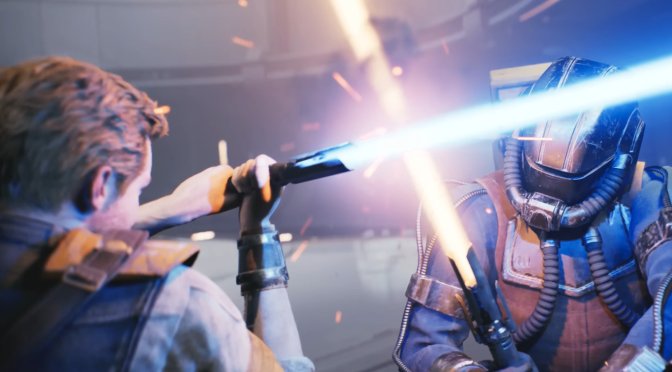A lot of PC players have been experiencing traversal stutters in numerous games. And finally, we have a solution for all the traversal stutters that plague the latest PC games. However, there is a catch.
Before continuing, I want to make it crystal clear that this isn’t a magic trick or a placebo effect. The solution is quite simple and we’ll explain later why it works. But before that, here are Star Wars Jedi: Survivor and Redfall without any traversal stutters.
Now if you looked at the framerate, you may have noticed a 30fps lock. And, that’s basically the trick you need to do in order to completely eliminate the traversal stutters in the latest PC games. By using Rivatunner, you can lock your framerate at 30fps. And no, don’t use any in-game frame limiter. Rivatunner’s frame limiter in most cases, and that’s the one we recommend using.
As showcased, Star Wars Jedi: Survivor runs with a flat frametime at 33.3ms, without any stutters while exploring the city of Koboh.
But what are exactly the traversal stutters? Simply put, these stutters can occur whenever the game loads new data during exploration. Most of the times, games divide their huge maps into smaller areas/zones. So, whenever a player visits or returns to different “areas“, the game will load their data. That’s the reason why traversal stutters can be reproduced so easily.
The reason the 30fps lock eliminates these traversal stutters is simple. At 30fps, the time it takes for the GPU to generate a frame is 33.3ms. So, in most current-gen games, SATA SSDs and NVMe SSDs can transfer the data a game needs during that timeframe without issues. Since it doesn’t take more time to transfer the data the game needs for its new/next zone, the game does not drop frames and runs consistently at 33.3ms. By increasing your framerate to even 60fps, you immediately lower the time it takes to generate a frame to 16.6ms. So, if a game needs, let’s say, 25ms to load the data of its next zone from your storage to your RAM, the GPU will halt and you’ll get a stutter. Pretty simple, right?
What you need to understand is that this is mainly a “storage -> RAM” issue. In other words, increasing your CPU power will not result in any improvements. And that’s because the bottleneck is not in the CPU. This is also why you’ll notice longer traversal stutters if you install the game on an HDD. Now if you decrease your CPU power then yes, you’ll get traversal stutters as the CPU may not be powerful enough to handle the amount of data that the game streams. Right now, high-end CPUs can handle the aforementioned games at 30fps without any stutters.
During our tests, we didn’t notice any difference between a SATA SSD and an NVMe SSD. This basically means that PC games can’t currently take advantage of the ridiculously high bandwidth of both the SATA SSD and the NVMe SSD. In theory, DirectStorage may be able to solve this issue, though we’ll have to wait and see.
So, what now? For games that are already out and have traversal stutters, you can experiment with lower framerates. In most cases, a 30fps lock will guarantee you a stutter-free experience. However, in really old games, you may get away with a 60fps lock. Understand that older games needed less data to transfer than current-gen games. Thus, you may be able to get a locked 60fps experience. If not, you can lock the framerate at a lower value until you get a flat frametime graph.
Now I know that 30fps sucks. And, IMO, a 60fps lock with some minor traversal stutters is a better experience than a 30fps locked game. However, this is THE ONLY way you can completely eliminate traversal stutters. In order to fully eliminate traversal stutters at 60fps in the latest games, like Star Wars Jedi: Survivor, there is nothing you can do. Nothing. There is no solution to that. Thankfully, a G-Sync monitor may reduce the side-effect of stuttering. It won’t completely fix it. However, it can make games feel a bit less stuttery.
Lastly, in this article, we are solely talking about traversal stutters. This 30fps lock will NOT resolve the shader compilation stutters. These stutters can only be fixed when a game compiles its shaders at launch.
So, does this mean that all current-gen games will always have traversal stutters? Not at all. But, this comes down to the developers, and whether they can properly optimize their game code. And trust us, there are ways to do this. And no, DirectStorage won’t be necessary for a stutter-free experience. After all, we’ve seen open-world games that can run smoothly on PC, without any stutters, on high framerates. So, it all comes down to the developers themselves, and whether they are capable of optimizing their games for high framerates.
In conclusion, if you want a stutter-free 60fps experience in the games that are already out, like Jedi Survivor or Redfall, you’ll have to wait – and hope – for a major optimization update. However, if you want, here and now, a stutter-free experience, you can get one by locking your framerate at 30fps!
John is the founder and Editor in Chief at DSOGaming. He is a PC gaming fan and highly supports the modding and indie communities. Before creating DSOGaming, John worked on numerous gaming websites. While he is a die-hard PC gamer, his gaming roots can be found on consoles. John loved – and still does – the 16-bit consoles, and considers SNES to be one of the best consoles. Still, the PC platform won him over consoles. That was mainly due to 3DFX and its iconic dedicated 3D accelerator graphics card, Voodoo 2. John has also written a higher degree thesis on the “The Evolution of PC graphics cards.”
Contact: Email

